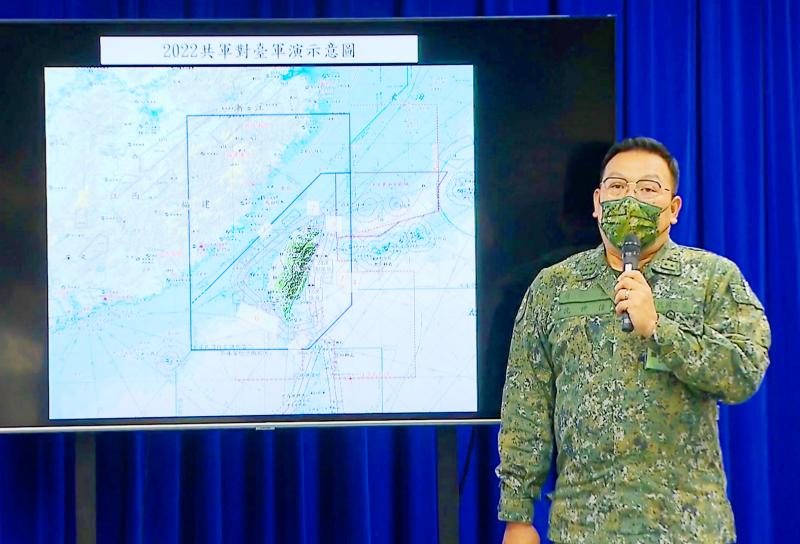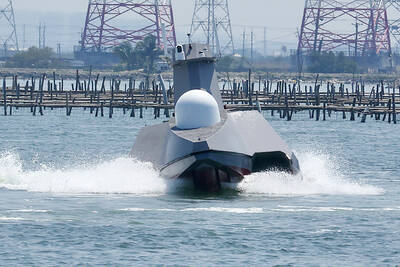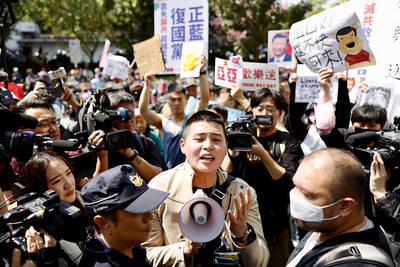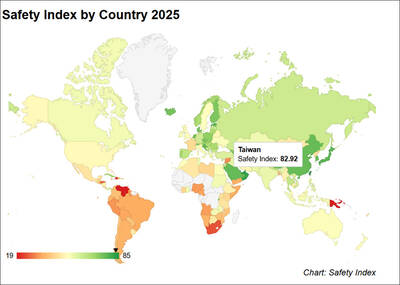The nation’s military fully complies with international rules and guidelines when responding to Chinese military drills, the Ministry of National Defense said yesterday, vowing to continue defending Taiwan in accordance with international law.
China on Thursday launched four days of military drills around Taiwan proper in response to US House of Representatives Speaker Nancy Pelosi’s visit to Taipei.
The drills were expected to end on Sunday, but neither Beijing nor Taipei confirmed their conclusion, although the Ministry of Transportation and Communications said it had seen some evidence suggesting at least a partial drawdown.

Photo courtesy of the Ministry of National Defense
However, China yesterday said the drills would continue, saying “the eastern theater of the Chinese People’s Liberation Army [PLA] continued to carry out practical joint exercises and training in the sea and airspace around Taiwan island.”
The exercises, the PLA’s Eastern Command said, were “focusing on organizing joint anti-submarine and sea assault operations.”
Beijing also carried out live-fire drills yesterday in parts of the South China Sea and Yellow Sea.
The Taiwanese defense ministry on Sunday said it detected 66 aircraft and 14 warships conducting naval and air exercises.
Taiwan has responded by putting its military on alert and deploying ships, planes and other assets to monitor Chinese aircraft, ships and drones that are “simulating attacks on the island of Taiwan and our ships at sea,” as well as crossing the median line of the Taiwan Strait.
Although not an internationally recognized delineation, the median line has been tacitly accepted by both sides since the 1950s, Shen Shih-wei (沈世偉), head of the ministry’s Judicial Department, told a news conference in Taipei yesterday.
Its existence is evident, but China’s creation of a restricted zone across the line challenges this nearly 70-year-old fact, he said.
The restricted zone constricts Taiwan’s training airspace, potentially affecting the normal operation of international air and waterways, Shen said.
This kind of targeted intimidation is contrary to Article 2, Section 4 of the UN Charter, which states: “All members shall refrain in their international relations from the threat or use of force against the territorial integrity or political independence of any state, or in any other manner inconsistent with the purposes of the United Nations,” Shen said.
Asked how the military monitors Chinese actions, Lieutenant General Yan Yu-hsien (顏有賢), Deputy Chief of the General Staff for Intelligence, said it uses joint intelligence, surveillance and reconnaissance methods.
For instance, when a Chinese aircraft or ship crosses the median line, the military — aside from broadcasting a warning — also communicates with warplanes and missile tracking systems to gain a thorough understanding of the situation, Yan said.
Warfare has changed dramatically in the Internet age, said Major General Chen Yu-lin (陳育琳), deputy director of the Political Warfare Bureau.
Disrupting the civilian Internet, cyberattacks would deepen the confrontation and potentially mean the difference between victory and defeat on the battlefield, she said.
China began cognitive warfare operations before the military drills, posting 272 messages from Monday last week to yesterday that were disseminated widely, ministry data showed.
The messages can be categorized into three types: creating a sense of unification by force, destroying trust in the government and disrupting morale, it said.
Navy Chief of Staff Vice Admiral Chiang Cheng-kuo (蔣正國) told reporters that China spread misinformation during the exercises.
It falsely claimed that its warships encroached on Taiwan’s territorial contiguous zone, but the navy confirmed that no PLA ships entered the nation’s territory, he said.
A country’s contiguous territorial zone extends for 24 nautical miles (44.4km) from its coast, while territorial waters extend 12 nautical miles. The military has not officially said whether PLA warships entered the nation’s contiguous zone.
Additional reporting by AP and AFP

ENDEAVOR MANTA: The ship is programmed to automatically return to its designated home port and would self-destruct if seized by another party The Endeavor Manta, Taiwan’s first military-specification uncrewed surface vehicle (USV) tailor-made to operate in the Taiwan Strait in a bid to bolster the nation’s asymmetric combat capabilities made its first appearance at Kaohsiung’s Singda Harbor yesterday. Taking inspiration from Ukraine’s navy, which is using USVs to force Russia’s Black Sea fleet to take shelter within its own ports, CSBC Taiwan (台灣國際造船) established a research and development unit on USVs last year, CSBC chairman Huang Cheng-hung (黃正弘) said. With the exception of the satellite guidance system and the outboard motors — which were purchased from foreign companies that were not affiliated with Chinese-funded

PERMIT REVOKED: The influencer at a news conference said the National Immigration Agency was infringing on human rights and persecuting Chinese spouses Chinese influencer “Yaya in Taiwan” (亞亞在台灣) yesterday evening voluntarily left Taiwan, despite saying yesterday morning that she had “no intention” of leaving after her residence permit was revoked over her comments on Taiwan being “unified” with China by military force. The Ministry of the Interior yesterday had said that it could forcibly deport the influencer at midnight, but was considering taking a more flexible approach and beginning procedures this morning. The influencer, whose given name is Liu Zhenya (劉振亞), departed on a 8:45pm flight from Taipei International Airport (Songshan airport) to Fuzhou, China. Liu held a news conference at the airport at 7pm,

Taiwan was ranked the fourth-safest country in the world with a score of 82.9, trailing only Andorra, the United Arab Emirates and Qatar in Numbeo’s Safety Index by Country report. Taiwan’s score improved by 0.1 points compared with last year’s mid-year report, which had Taiwan fourth with a score of 82.8. However, both scores were lower than in last year’s first review, when Taiwan scored 83.3, and are a long way from when Taiwan was named the second-safest country in the world in 2021, scoring 84.8. Taiwan ranked higher than Singapore in ninth with a score of 77.4 and Japan in 10th with

GRIDLOCK: The National Fire Agency’s Special Search and Rescue team is on standby to travel to the countries to help out with the rescue effort A powerful earthquake rocked Myanmar and neighboring Thailand yesterday, killing at least three people in Bangkok and burying dozens when a high-rise building under construction collapsed. Footage shared on social media from Myanmar’s second-largest city showed widespread destruction, raising fears that many were trapped under the rubble or killed. The magnitude 7.7 earthquake, with an epicenter near Mandalay in Myanmar, struck at midday and was followed by a strong magnitude 6.4 aftershock. The extent of death, injury and destruction — especially in Myanmar, which is embroiled in a civil war and where information is tightly controlled at the best of times —